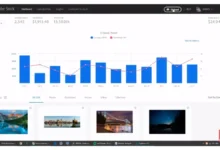Instanavigation: The Future of Seamless Navigation

Introduction To Instanavigation
The digital world is continuously evolving, and with that evolution comes the demand for quicker, more efficient ways to navigate through information. Enter Instanavigation, a revolutionary concept in digital navigation that promises to change the way users interact with web pages, apps, and devices. In this article, we will delve into what Instanavigation is, how it works, and its implications for the future of digital user experiences.
What is Instanavigation?
It refers to a technology or feature that allows users to move from one point to another on a website or within an application instantaneously, without any noticeable lag or loading time. Unlike traditional navigation systems, where loading pages or data might involve delays due to server responses, data processing, or bandwidth limitations, Instanavigation leverages advanced technologies to offer seamless transitions.

Origins of Instanavigation
The idea of improving navigation is not new. Since the advent of the internet, web developers and designers have been focused on enhancing the user experience by reducing load times and simplifying navigation processes. Techniques like caching, server optimization, and content delivery networks (CDNs) have long aimed at minimizing delays. Instanavigation takes this concept one step further, integrating more sophisticated methods such as preloading, advanced caching, and predictive algorithms to ensure that users can move around in digital spaces as if they were flicking through pages in a book.
How Instanavigation Works
It operates on several technological principles to achieve instantaneous transitions:
1. Preloading Content
Instanavigation employs predictive algorithms to determine what content a user is likely to access next. It then preloads this content in the background while the user is still engaging with the current page or section. This eliminates the wait time traditionally experienced when moving from one page to another.
2. Advanced Caching Mechanisms
Caching has long been a staple of speeding up web experiences, but pushes this further by optimizing how and what is cached. Instead of just saving frequently accessed data, it preemptively caches the next set of information based on user behavior. This ensures that content loads almost instantaneously when accessed.
3. Predictive Algorithms
Machine learning and AI are central to Instanavigation. These systems analyze user behavior, patterns, and preferences to predict where they might go next. This predictive approach allows the system to prepare content ahead of time, offering users a frictionless experience.
4. Edge Computing
Edge computing, where data processing is done closer to the user’s physical location, plays a critical role in reducing latency. With servers and data centers spread across various locations globally, It leverages this to bring content to users faster, reducing the distance and time it takes for data to travel from server to user.
Advantages of Instanavigation
Instanavigation presents numerous benefits that promise to reshape the digital landscape. Here are some of the key advantages:
1. Enhanced User Experience
One of the most significant advantages of Instanavigation is the improved user experience. The near-instantaneous load times reduce friction, making users more likely to stay on a website or app. A smooth and responsive interface is key to keeping users engaged.
2. Reduced Bounce Rates
Websites often struggle with high bounce rates, where users leave after viewing just one page. It minimizes this by offering seamless transitions between pages, encouraging users to explore more content without the frustration of waiting for pages to load.
3. Increased Conversions
Whether for e-commerce websites, subscription services, or online learning platforms, smoother navigation can lead to higher conversion rates. When users can move quickly through a platform, finding what they need without any delays, they are more likely to complete purchases, sign-ups, or other desired actions.
4. Accessibility and Inclusivity
Instanavigation can also play a role in making websites and apps more accessible. For users with slower internet connections or those in regions with less reliable infrastructure, Instanavigation ensures that they can still access content without excessive delays. This makes digital platforms more inclusive and globally accessible.
Challenges in Implementing Instanavigation
Despite its many benefits, Instanavigation is not without challenges. While the technology behind it is powerful, implementing it requires careful planning and resources.
1. Resource-Intensive
Developing and maintaining an Instanavigation system can be resource-intensive. It requires robust infrastructure, including predictive algorithms, advanced caching systems, and edge computing networks. Smaller businesses or websites with limited budgets may find it challenging to adopt this technology.
2. Privacy Concerns
Predictive algorithms rely on user data to make accurate predictions about navigation. This raises concerns about data privacy. Users may be uncomfortable with websites or applications analyzing their behavior too closely. Companies need to balance the benefits of Instanavigation with the ethical responsibility of safeguarding user data.
3. Compatibility
Not all devices or platforms may be optimized for Instanavigation. While many modern websites and apps are moving towards this technology, older systems or less advanced platforms may struggle to implement it effectively.
Instanavigation in E-Commerce
One of the industries that stands to benefit the most from Instanavigation is e-commerce. In an online shopping environment, speed and efficiency are critical to the customer experience. Every second a customer waits for a page to load is a potential lost sale. By integrating Instanavigation, e-commerce platforms can ensure that users can quickly browse products, add them to their cart, and check out without any delays.
For example, an online clothing store could preload images, product descriptions, and even checkout pages based on what the system predicts the user will do next. This means that when the user clicks to view a product or moves to the checkout process, everything loads instantly, creating a seamless and enjoyable shopping experience.
The Future of Instanavigation
As more industries adopt this technology, the future of Instanavigation looks promising. Here are some ways it could evolve:
1. Integration with Augmented Reality (AR) and Virtual Reality (VR)
With the rise of AR and VR technologies, Instanavigation could become crucial for immersive digital experiences. Seamless transitions in virtual spaces will be essential to maintaining the illusion of immersion, and Instanavigation could play a key role in ensuring smooth experiences within these environments.
2. Expansion to IoT Devices
Instanavigation could also extend beyond websites and apps, integrating with Internet of Things (IoT) devices. Smart homes, connected cars, and wearable technology could benefit from instant transitions between tasks or commands, enhancing user experience across all devices.
3. Enhanced Personalization
As AI continues to evolve, Instanavigation will likely become even more personalized. Systems could predict user preferences with increasing accuracy, tailoring navigation not just based on behavior but also on factors like mood, time of day, or even previous interactions.
Conclusion
Instanavigation represents a significant leap forward in digital navigation technology. Its ability to offer near-instantaneous transitions between different sections of a website, app, or device has the potential to revolutionize user experiences across various industries. Despite challenges such as resource intensity and privacy concerns, the advantages—ranging from enhanced user experiences to higher conversion rates—make it a highly valuable tool for the future. As the digital world continues to evolve, it will likely play a crucial role in shaping how users interact with content and devices, pushing the boundaries of what’s possible in the realm of seamless digital navigation.




